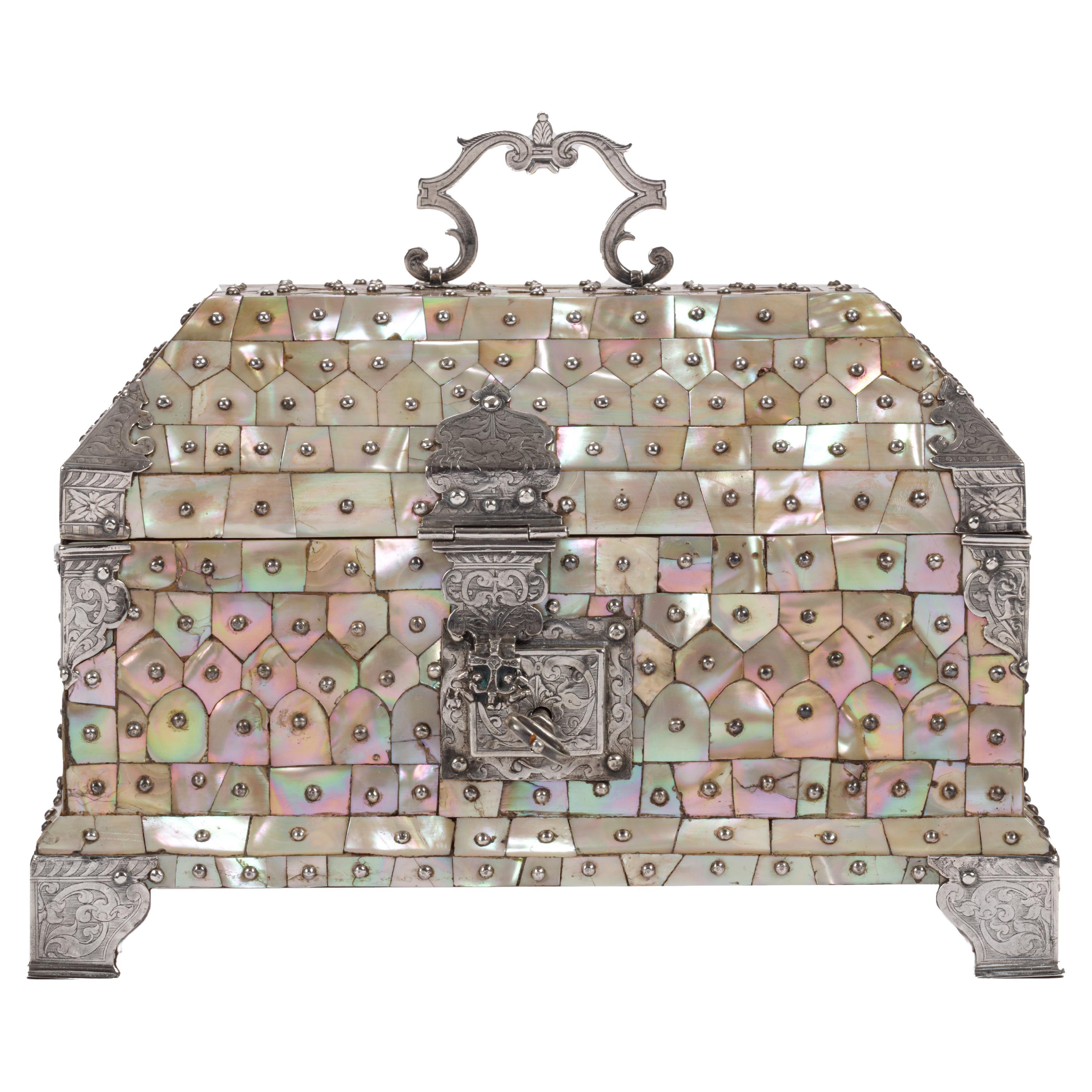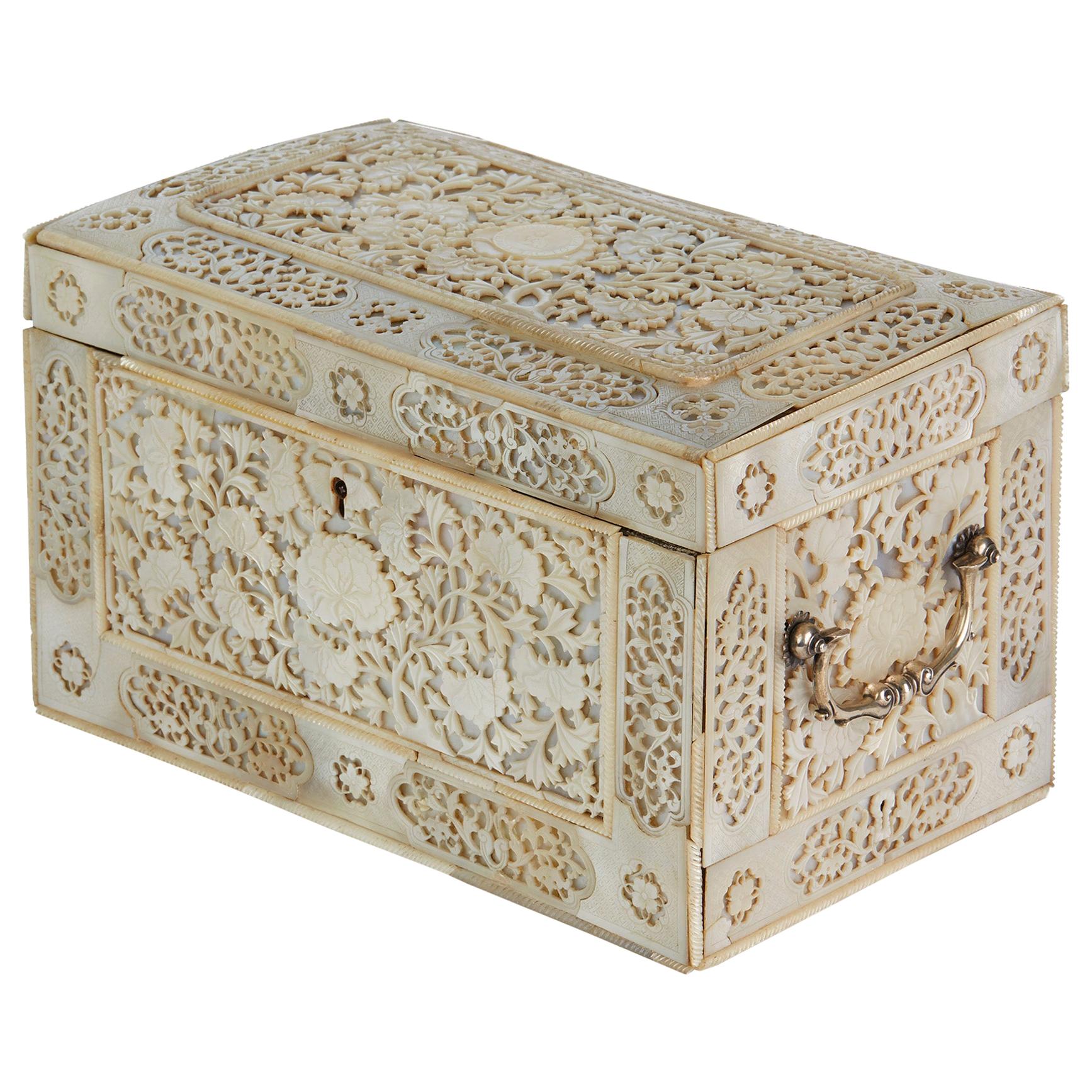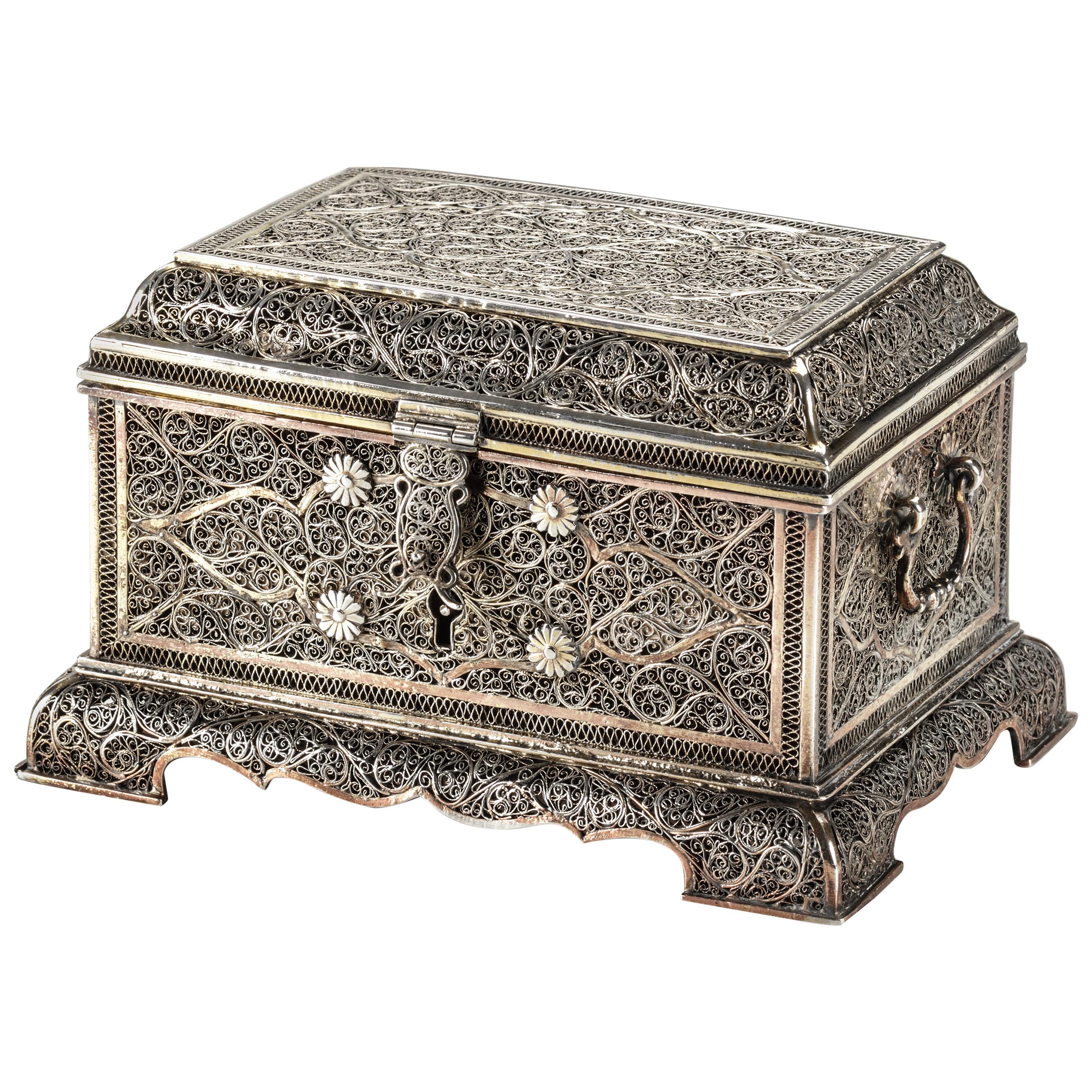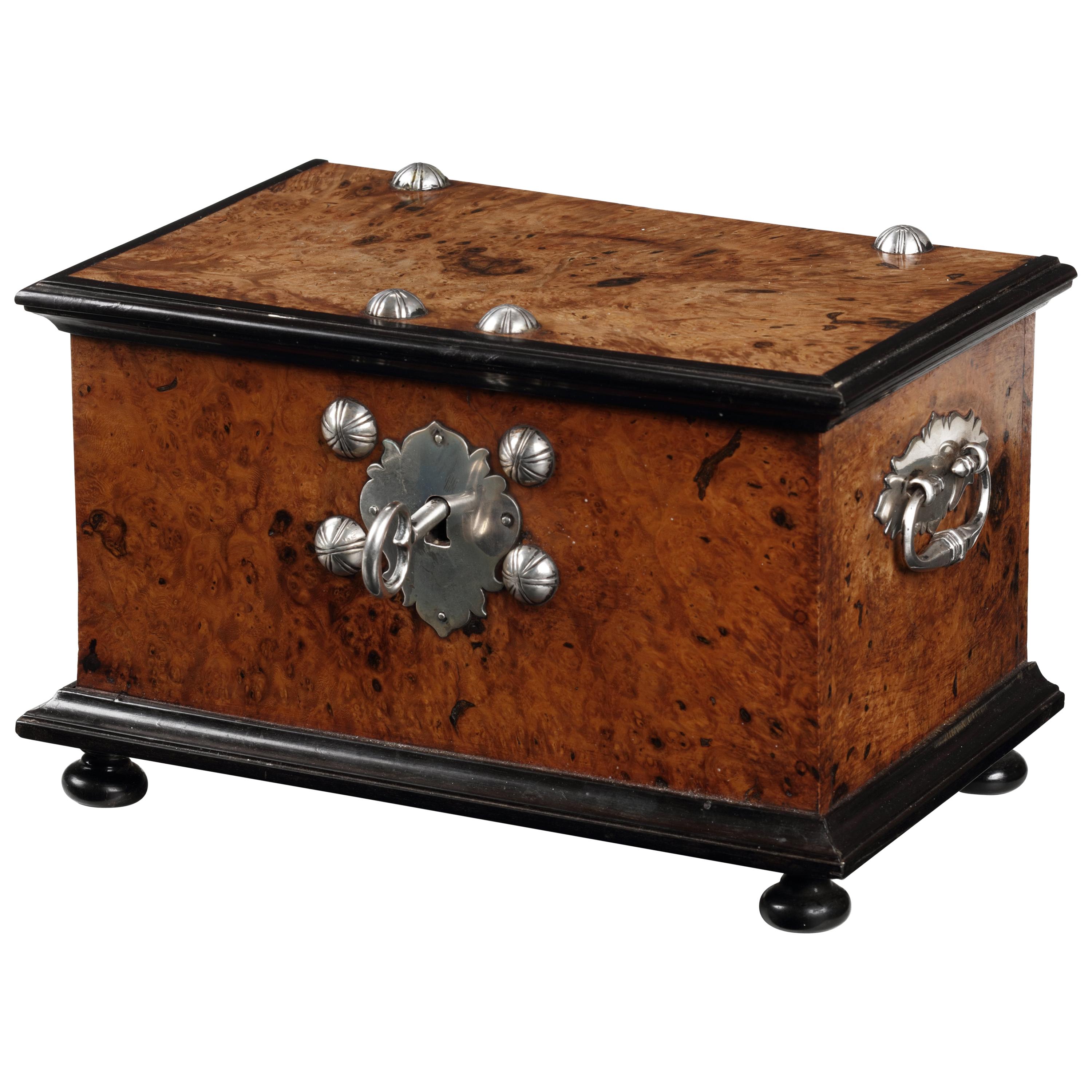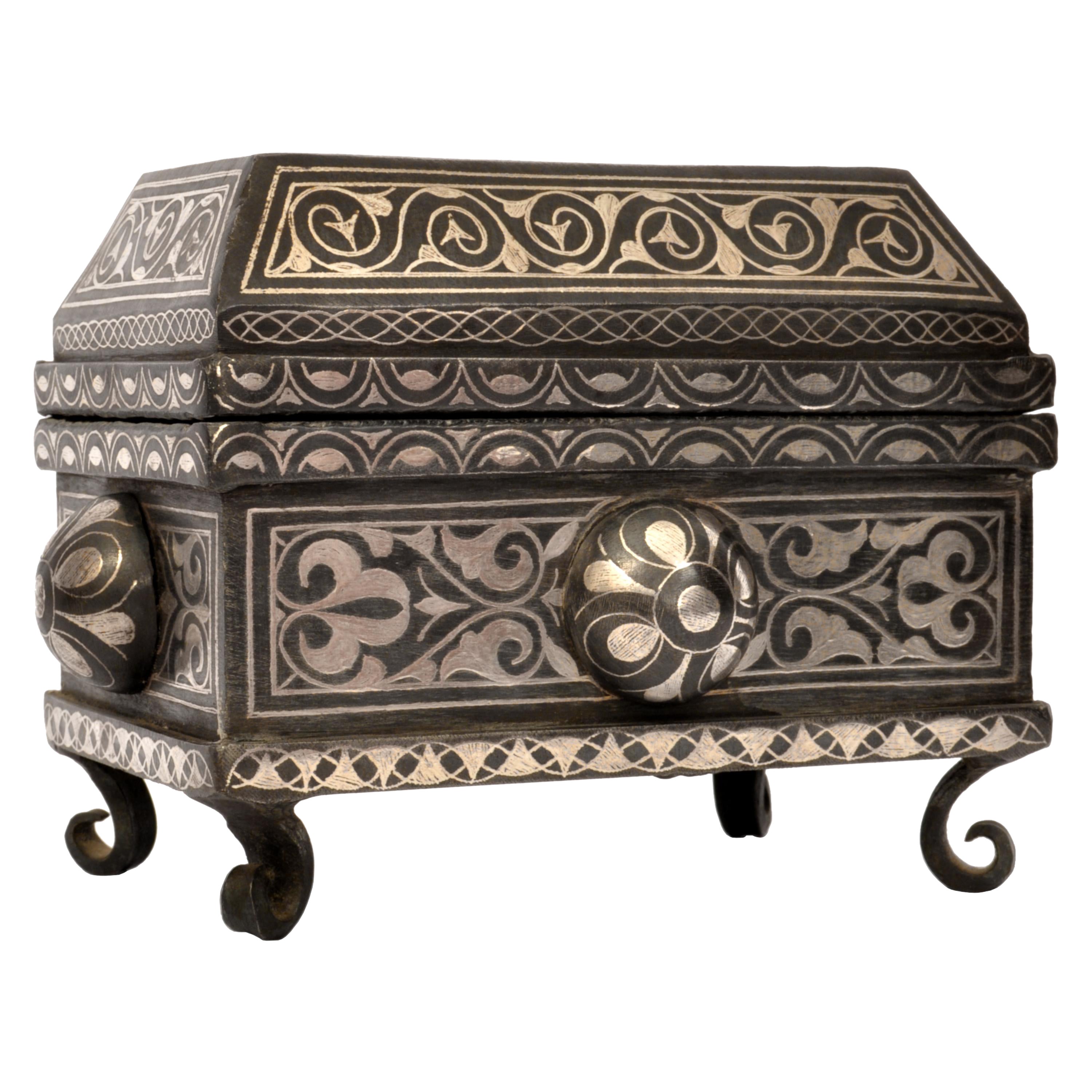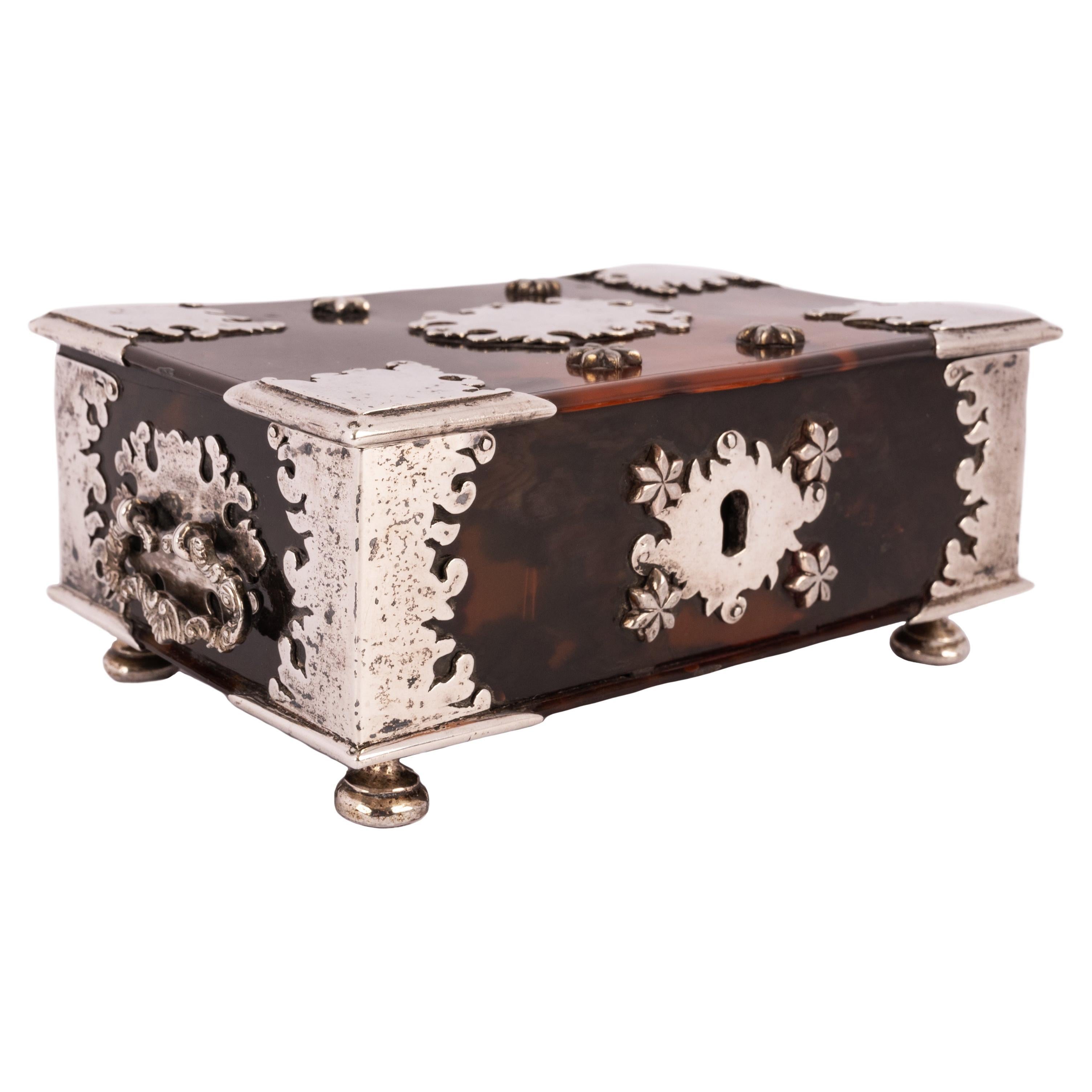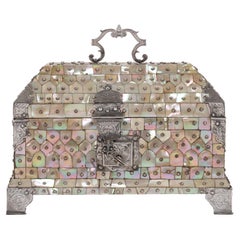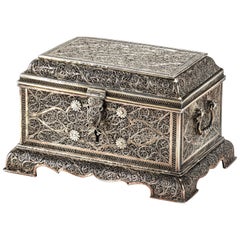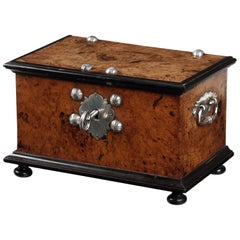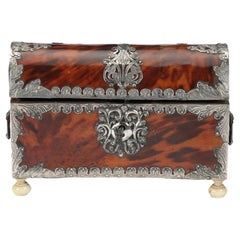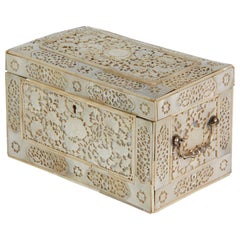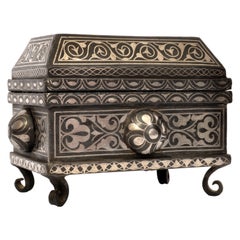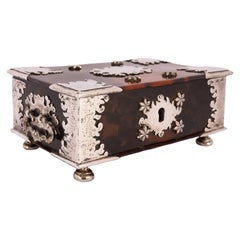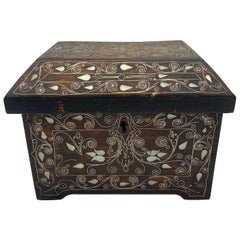Items Similar to 18th-century Dutch-colonial Peranakan mother-of-pearl casket with silver mounts
Want more images or videos?
Request additional images or videos from the seller
1 of 7
18th-century Dutch-colonial Peranakan mother-of-pearl casket with silver mounts
$33,020.62
£24,716.76
€28,000
CA$45,445.79
A$50,654.07
CHF 26,576.45
MX$618,568.74
NOK 336,515.66
SEK 318,058.48
DKK 213,155.72
About the Item
An Indonesian Peranakan mother-of-pearl inlaid mastic sirih casket with silver mounts
Jakarta (Batavia), circa 1720-1730, the silver hinges marked for Batavia, maker’s mark HS or SH, part of the silver reconstructed
H. 10 x W. 26 x D. 17.5 cm
Before settling down to business in the former Dutch East Indies, sirih had to be offered in the most exquisite boxes, made of gold, silver, inlaid with precious stones, ivory, tortoiseshell, or, as the present one, inlaid with mother-of-pearl. The costliness of one’s sirih box displayed one’s fortunes.
In this manner, only one other sirih box in mother-of-pearl is documented. It is in the collection of Kip-Lee-Kip in Singapore (Peter Lee et al., Port Cities: Multicultural Emporiums of Asia, 1500-1900, Asian Civilizations Museum, Singapore, 2016, p.206, no. 166).
At least one of the previous owners of the casket presented here seemed to have been aware of the importance of this box since it possibly lost part of its silver but was restored with finely engraved openwork late 17th/early 18th century mounts. When observed closely, the box shows several nail holes all over, suggesting closed silver corner and centrepieces, and lock plate.
Researching a large number of sirih caskets, in design related and also for the Peranakan market, as this casket probably is, we asked a highly skilled restorer to design and reconstruct the missing silver mounts – with an astonishing result.
It is unknown who the silversmith HS or SH, active between circa 1714 and circa 1743, is, but he did leave an impressive oeuvre of a very high standard. The Kunstmuseum in The Hague has seven commemorative salvers, a walking stick and a cuspidor with these marks in the collection. For another and so far the latest dated salver by HS or SH, commemorating Bartha Helena van Suchtelen, born in Batavia (Jakarta) in 1710 and deceased there in 1743, see Uit Verre Streken, March 2013, no. 4.
- Dimensions:Height: 3.94 in (10 cm)Width: 10.24 in (26 cm)Depth: 6.89 in (17.5 cm)
- Style:Dutch Colonial (Of the Period)
- Materials and Techniques:
- Place of Origin:
- Period:
- Date of Manufacture:1720-1730
- Condition:Replacements made: The silver middle corner pieces, the center piece on the lid, lockplate and plates behind the hinges have been replaced by newly made pieces in style with the original silver mounts (corner pieces top and bottom and hinges) in 18th century silver. Wear consistent with age and use. Minor losses. Minor fading. Cleaned, some MOP pieces replaced, fragile material so in a good condition for the age.
- Seller Location:Amsterdam, NL
- Reference Number:1stDibs: LU5458231460622
About the Seller
5.0
Recognized Seller
These prestigious sellers are industry leaders and represent the highest echelon for item quality and design.
Established in 1985
1stDibs seller since 2020
23 sales on 1stDibs
Typical response time: 2 hours
- ShippingRetrieving quote...Shipping from: Amsterdam, Netherlands
- Return Policy
Authenticity Guarantee
In the unlikely event there’s an issue with an item’s authenticity, contact us within 1 year for a full refund. DetailsMoney-Back Guarantee
If your item is not as described, is damaged in transit, or does not arrive, contact us within 7 days for a full refund. Details24-Hour Cancellation
You have a 24-hour grace period in which to reconsider your purchase, with no questions asked.Vetted Professional Sellers
Our world-class sellers must adhere to strict standards for service and quality, maintaining the integrity of our listings.Price-Match Guarantee
If you find that a seller listed the same item for a lower price elsewhere, we’ll match it.Trusted Global Delivery
Our best-in-class carrier network provides specialized shipping options worldwide, including custom delivery.More From This Seller
View All16th-Century Indo-Portuguese Colonial Mother-of-pearl Gujarat Casket
Located in Amsterdam, NL
An exceptional Indo-Portuguese colonial mother-of-pearl veneered casket with silver mounts
India, Gujarat, 2nd half of the 16th century, the silver mounts Goa or probably Lisbon
Measures: H. 16 x W. 24.6 x D. 16.1 cm
An exceptional Gujarati casket with a rectangular box and truncated pyramidal lid (with slopes on each side and a flat top) made from exotic wood, probably teak (Tectona grandis), covered with a mother-of-pearl mosaic. The tesserae, cut from the shell of the green turban sea snail (Turbo marmoratus, a marine gastropod) in the shape of fish scales, are pinned to the wooden structure with silver ball-headed nails. The casket is set on bracket feet on the corners. The masterfully engraved decoration of the silver mounts follows the most refined and erudite Mannerist repertoire of rinceaux and ferroneries dating from the mid-16th century. The high quality and refinement of the silver mounts and, likewise, the silver nails that replaced the original brass pins used to hold the mother-of-pearl tesserae in place indicate the work of a silversmith probably working in Lisbon in the second half of the 16th century.
The Indian origin of this production, namely from Cambay (Khambhat) and Surat in the present state of Gujarat in north India, is, as for the last three decades, consensual and fully demonstrated, not only by documentary and literary evidence - such as descriptions, travelogues and contemporary archival documentation - but also by the survival in situ of 16th-century wooden structures covered in mother-of-pearl tesserae. A fine example is a canopy decorating the tomb (dargah) of the Sufi saint, Sheik Salim Chisti (1478-1572) in Fatehpur Sikri in Agra district in the state of Uttar Pradesh, north India. This is an artistic production, geometric in character and Islamic in nature, where usually the mother-of-pearl tesserae form complex designs of fish scales or, similar to the dishes also made using the same technique, with the thin brass sheets and pins, stylized lotus flowers. The truncated pyramidal shape corresponds, like their contemporary tortoiseshell counterparts also made in Gujarat, to a piece of furniture used in the Indian subcontinent within the Islamic world prior to the arrival of the first Portuguese. This shape, in fact, is very old and peculiar to East-Asian caskets, chests or boxes used to contain and protect Buddhist texts, the sutras.
A similar chest is the famous and large reliquary chest from Lisbon cathedral that once contained the relics of the city's patron saint, Saint Vincent. Both match in shape, having the same kind of socle or pedestal and bracket feet, and in their engraved silver mountings, featuring the same type of refined, erudite decoration. Their differences lie in the silver borders that frame the entire length of the edges of the chest (both the box and the lid), pinned with silver nails, and on the lock plate, shaped like a coat of arms in the Lisbon example. Given the exceptional dimensions of the reliquary casket...
Category
Antique 16th Century Indian Jewelry Boxes
Materials
Silver
Fine Indian Silver Filigree Casket with Hinged Cover, 18th Century
Located in Amsterdam, NL
A pair of very fine silver filigree rosewater sprinklers
Possibly India, Karimnagar, early 18th century
Measures: Height 31.6 cm and 31.7 cm,...
Category
Antique 18th Century Indian Metalwork
Materials
Silver
Fine Dutch Colonial Indonesian Casket with Silver Mounts, circa 1706
Located in Amsterdam, NL
A fine Indonesian Ambonya burl, ebony and teak casket with silver mounts
Jakarta (Batavia), circa 1706 (year letter W (1705-1710), marked DV, probably Dirck Vooght
The outer ri...
Category
Antique Early 18th Century Indonesian Dutch Colonial Decorative Boxes
Materials
Sterling Silver
A colonial tortoiseshell veneered casket with silver mounts
Located in Amsterdam, NL
Possibly Spanish colonial, 17th century
H. 15.2 x W. 25.1 x D. 12 cm
Included is a hand-written letter, reading:
Ik Ondergetekenden verklare bij dezen, dat mijn Wel en Begeerte is...
Category
Antique 17th Century Mexican Antiquities
Materials
Silver
A superb Dutch-colonial Indonesian silver filigree sirih box
Located in Amsterdam, NL
Probably Sumatra, Padang, 18th century
H. 8.4 x W. 22.5 x D. 15.3 cm
Weight 1700 grams
Due to the form of this box, together with the date, the most likely place of production of t...
Category
Antique 18th Century Indonesian Dutch Colonial Jewelry Boxes
Materials
Silver
A highly refined Dutch-colonial Sri Lankan inlaid box with silver mounts
Located in Amsterdam, NL
Galle district, 18th century
The box is made of amboyna burr with inlays of ebony, bone and burr wood and has several interior compartments, all made with the utmost attention to de...
Category
Antique 18th Century Sri Lankan Decorative Boxes
Materials
Bone, Ebony, Amboyna
You May Also Like
Chinese Large Mother of Pearl Mounted Armorial Tea Caddy for MacPherson
Located in Bishop's Stortford, Hertfordshire
A rare, incredible and large antique Chinese carved mother of pearl mounted tea caddy with armorial for MacPherson and dating from circa...
Category
Antique 1770s Chinese Qing Tea Caddies
Materials
Mother-of-Pearl
Antique 19th Century Indian Bidriware Pandan Silver & Brass Casket Jewelry Box
Located in Portland, OR
Antique early 19th century Indian Bidriware silver and brass Pandan casket, Circa 1800.
Bidriware is credited to the Bahamani Sultans who were the rulers of Bidar in the Northeast part of the state of Karnataka, India in the 14th & 15th centuries, the artform has its roots in ancient Persia and was thought to be brought to India by the 13th century Sufi mystic Mu'in al-Din Chishti. A pandan box...
Category
Antique Early 1800s Indian Islamic Metalwork
Materials
Silver, Brass
Antique Dutch Colonial VOC Batavian Tortoise Shell Silver Sirih Casket 1750
Located in Portland, OR
A rare, Dutch Colonial, Batavian (now Jakarta) Dutch East Indies silver and tortoise shell Sirih casket, circa 1750.
The casket was used for storing highly prized betel nut, which was chewed ritually by high ranking Indonesian officials and adopted by settlers from the Dutch East Indies Company...
Category
Antique 1750s Indonesian Dutch Colonial Metalwork
Materials
Silver
$5,200 Sale Price
20% Off
Free Shipping
19th Century Chinese Silverwire Wooden Box Mother of Pearl Design
Located in Brea, CA
19th century Chinese silverwire wooden box with mother of pearl design from the Qing Dynasty. Beautiful intricate floral designs all-over.
Category
Antique 19th Century Chinese Qing Decorative Boxes
Materials
Wood
English Mother of Pearl carved casket box with abalone inlay
Located in Winnetka, IL
English MOP carved casket box with abalone inlay. Velvet lining on 4 bracket feet
Category
Early 20th Century English Decorative Boxes
Materials
Abalone, Mother-of-Pearl, Wood
19th Century oriental chest inlaid with mother of pearl
Located in Diest, BE
19th Century Syrian oriental chest inlaid with mother of pearl. Handcrafted Middle Eastern wedding gift from parent to the bride. Great patina.
Category
Antique 19th Century Syrian Islamic Blanket Chests
Materials
Iron
More Ways To Browse
Mid Century Colonial
Mark Dutcher
18th Century Colonial Furniture
Mother Of Pearl Plate
Asian Plate Display
Ivory Inlay Furniture
Indonesia Jakarta
Dutch Inlay
17th Century Dutch Silver
Dutch Silver Box
Mother Of Pearl Inlay Lacquer
Stick Pearl
17th Century Pearl
Antique Asian Mother Of Pearl Furniture
Gold Casket
Mid Century Nail Art
Silver Casket
Mother Of Pearl Inlayed Boxes
